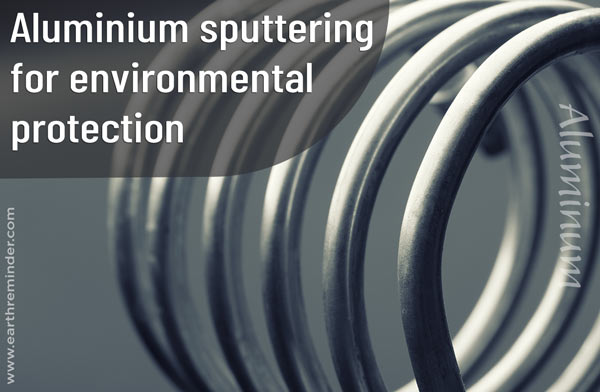Aluminum Sputtering and its Usage for Environmental Protection
Aluminum Sputtering Usage for Environmental Protection:
For many reasons, sustainability is essential, especially the environmental quality. Healthy communities need clean air, natural resources, and a non-toxic environment. The continuous growth of population and the advancement of technologies require more energy, water, and space.
Sustainable development aims to balance environmental, social and economic needs, allowing prosperity. These include social equality, conservation of natural resources, environmental protection, and stable economic growth.
Sputtering is a physical vapor deposition procedure of specific metals to form thin films over the surface for protection. The thickness of the layer varies as per application from nanometers up to microns. Sputtering consists of collisions of ions in a vacuum and a plasma environment under a strong magnetic field to extract atoms from the metal sputtering target and gradually grow a thin film over the desired substrate. Sputtering is used broadly in the semiconductor industry to place thin films of various incorporated circuit processing materials. For optical application, thin anti-reflection coatings on the glass are deposited by sputtering.
What is Physical vapor deposition?
Physical Vapor Deposition (PVD) is a technique in which we deposit a metal vapor to form a thin alloy coating over electrical conductors for protection. It is sometimes also called as Physical Vapor Transport. Common techniques used in it are evaporation and sputtering.
The conventional approach to the environmental management of businesses and industries mostly focuses on facility-level conformity and control. This approach specifies only a single stage in the life-cycle of a product that means less recycling. For this purpose, a proper sputtering martial should be considered that allows long life and protection to the surface, used safely without any adverse effects on the environment. All of these qualities lie on Aluminum sputtering.
Table of Contents
Aluminum Sputtering:
Aluminum is an elemental material with basic properties. Aluminum does not transform with physical or mechanical processing. This indicates that aluminum is fundamentally sustainable. Once shaped, it can be recycled frequently without any loss in quality. It is an amazing metal that can be reused in any product. For example, it can aid in manufacturing and saving of industrial as well as consumer products.
In comparison with carbon-based organic compounds, such as wood, natural fibers, and plastics, are composed of large molecules. With the repeated heating, cooling and mechanical processing destroy the bonding molecules to arrangement in individual molecules, thereby changing the original properties of the material but aluminium composes its molecular properties after processing which make it ideal for sputtering.
Properties of Aluminum which make it suitable for Sputtering:
The elemental nature of aluminum has unique physical properties; that are:
Aluminum has a very high strength-to-weight ratio:
Strength to weight ratio is useful, where we need to know the usability of a material. We can calculate the strength-to-weight ratio by dividing the strength of the material by the weight.
Due to a higher strength-to-weight ratio, aluminum is used widely for sputtering as well as other commercial purposes.
Aluminum alloys have excellent thermal and electric conductivity:
While choosing materials, thermal and electrical conductivity are two significant factors. Due to high thermal conductivity, Aluminum alloys are more comfortable to melt at a much lower temperature. Furthermore, high electrical conductivity makes them a good fit as electrical conductors.
Aluminum is great in corrosion resistance:
Aluminum coating over other metals prevents them from corrosion by controlling the reaction with oxygen. Therefore, aluminum sputtering is widely used in the industrial atmosphere.
It has perfect elasticity, malleability and reflectivity:
Besides, aluminum alloys are highly elastic and malleable. They are easy to utilize due to these extraordinary physical properties. The perfect surface reflectivity of this material is another property to consider while thinking about its sputtering and environmental sustainability.
This fundamental physical rareness of aluminium has enabled aluminium sputtering for high-quality and sustainability.
Advantage of Aluminum sputtering for sustainability
There are many features that other metals also inherit for perfect sputtering metal but no other metal can equivalent to aluminium’s sustainability advantage or its blend of unique physical properties:
• Unbeatable Strength:
Pure aluminium is sufficiently soft to carve. When it is mixed with other elements to form alloys, it can transform to stronger as the strength of steel but only half of the weight.
• Durability of the product:
Aluminium is tough enough to resist the rigors of spaceflight as well as challenging climatic conditions, such as those challenges found in seaside or in the Arctic environments, which make this metal suitable for a long life of aircraft and ships, That means less rusty machinery.
• Flexibility:
The physical properties of aluminium allow this metal and its alloys to be shaped easily by any of the primary industrial metalworking processes like forging, rolling, casting or extrusion.
• Impermeability
Aluminium forms an advanced barrier for food and packaging by preventing harmful factors and microorganisms from reaching the contents inside and enhances the shelf life of the product.
• Low Weight
Aluminium can lower the weight of a vehicle, reducing fuel and emissions. It aids lighten structures in packaging and shipping.
• Corrosion Resistance
Aluminium oxide glazing provides efficient protection against deprivation from water, air, and temperature difference.
• Recyclability
Recycling of Aluminum can be done repeatedly with low cost, using 5 % of the energy and generating 5 % of the primary production emissions.
Conclusion:
Aluminum, along with its unique physical properties, is utilizing globally. Commercially it has a significant effect on the stability of other materials. In addition to industrial usage, aluminum is also sustained as an environmentally friendly material. Due to the protective application of this material, our economy gets benefits mostly and can be utilized as an alternative to several other metallic compounds.
References: (PDF Form) –
